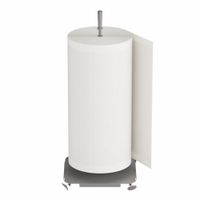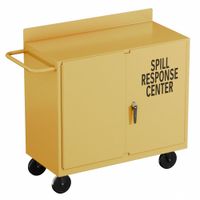Call +(254) 703 030 000 / 751 483 999 / 721 704 777
- Home
- Safety
- Sorbents Spill Control Spill Containment
- Sorbents Spill Kits
- Cabinets Carts Dispensers For Sorbents
.....Read More
Frequently Asked Questions
What are the benefits of using spill cabinets and carts for sorbents?
Spill cabinets and carts for sorbents offer several benefits, enhancing safety, efficiency, and compliance in environments where spills are a risk:
1. **Organization and Accessibility**: Spill cabinets and carts keep sorbents organized and easily accessible. This ensures that in the event of a spill, the necessary materials can be quickly located and deployed, minimizing response time and potential damage.
2. **Mobility**: Carts provide mobility, allowing sorbents to be transported swiftly to the site of a spill. This is particularly beneficial in large facilities where spills may occur at various locations.
3. **Space Efficiency**: Cabinets and carts are designed to store a variety of sorbents in a compact manner, optimizing space usage. This is crucial in facilities where space is limited.
4. **Protection and Longevity**: These storage solutions protect sorbents from environmental factors such as moisture and dust, which can degrade their effectiveness. This ensures that sorbents remain in optimal condition for use.
5. **Compliance and Safety**: Proper storage of sorbents in designated cabinets and carts helps facilities comply with safety regulations and standards. This reduces the risk of penalties and enhances workplace safety.
6. **Inventory Management**: Cabinets and carts facilitate better inventory management by providing a clear view of available supplies. This helps in maintaining adequate stock levels and planning for replenishments.
7. **Versatility**: They can accommodate various types of sorbents, including pads, rolls, and booms, making them versatile for different spill scenarios.
8. **Cost-Effectiveness**: By preventing sorbent degradation and ensuring quick spill response, these storage solutions can reduce the overall costs associated with spill management and cleanup.
Overall, spill cabinets and carts are essential tools for effective spill management, promoting a safer and more efficient workplace.
How do I choose the right sorbent dispenser for my needs?
1. **Identify the Spill Type**: Determine the type of liquid or chemical you need to manage. Different sorbents are designed for oil, water, or chemical spills.
2. **Assess the Volume**: Estimate the volume of the spill you typically handle. This will help you choose a dispenser with the appropriate capacity.
3. **Consider the Environment**: Evaluate the environment where the dispenser will be used. Indoor or outdoor settings, temperature, and potential exposure to elements can influence your choice.
4. **Select the Sorbent Material**: Choose between materials like polypropylene, cellulose, or natural fibers based on the spill type and environmental considerations.
5. **Evaluate Dispenser Types**: Decide between portable, wall-mounted, or floor-standing dispensers based on space availability and mobility needs.
6. **Check for Compatibility**: Ensure the dispenser is compatible with the sorbent material you plan to use.
7. **Ease of Use**: Look for features like easy loading, dispensing, and maintenance to ensure efficient operation.
8. **Safety Features**: Consider dispensers with safety features such as spill containment, non-slip bases, or lockable compartments.
9. **Budget Constraints**: Balance your needs with your budget, considering both initial costs and long-term maintenance.
10. **Regulatory Compliance**: Ensure the dispenser meets any industry-specific regulations or standards.
11. **Supplier Reputation**: Choose a reputable supplier known for quality products and reliable customer service.
12. **Trial and Feedback**: If possible, trial a dispenser or seek feedback from other users to gauge performance and satisfaction.
By considering these factors, you can select a sorbent dispenser that effectively meets your spill management needs.
What types of sorbents can be stored in these cabinets and carts?
Cabinets and carts designed for storing sorbents typically accommodate a variety of sorbent types, each suited for different spill scenarios. These include:
1. **Universal Sorbents**: These are versatile and can absorb a wide range of liquids, including water-based and oil-based spills. They are often made from polypropylene and are suitable for general-purpose use.
2. **Oil-Only Sorbents**: Specifically designed to absorb hydrocarbons like oil, gasoline, and diesel, these sorbents repel water, making them ideal for marine and outdoor applications where oil needs to be separated from water.
3. **Chemical Sorbents**: These are used for hazardous chemical spills and are made from materials that can safely absorb and neutralize aggressive chemicals, including acids and bases. They are essential in laboratories and industrial settings where chemical spills are a risk.
4. **Hazmat Sorbents**: Similar to chemical sorbents, these are designed for hazardous material spills and can handle a variety of dangerous substances. They are often color-coded for easy identification and compliance with safety regulations.
5. **Granular Sorbents**: These are loose, granular materials that can be spread over spills to absorb liquids. They are often used for large spills and can be made from clay, silica, or other absorbent materials.
6. **Specialty Sorbents**: These include sorbents designed for specific applications, such as mercury spill kits or sorbents for radioactive materials. They are tailored to handle unique spill scenarios safely.
Storing these sorbents in dedicated cabinets and carts ensures they are organized, easily accessible, and protected from environmental factors that could compromise their effectiveness. Proper storage also aids in compliance with safety regulations and facilitates quick response during spill emergencies.
How do sorbent roll dispensers work?
Sorbent roll dispensers are designed to efficiently store, dispense, and manage sorbent materials used for absorbing spills, leaks, or drips of liquids such as oil, water, or chemicals. These dispensers typically consist of a sturdy frame or housing that holds a roll of sorbent material, which can be made from various absorbent substances like polypropylene, cellulose, or natural fibers.
The dispenser is equipped with a mechanism that allows the user to easily unroll and tear off the desired length of sorbent material. This mechanism often includes a cutting edge or serrated blade to facilitate clean and precise tearing. Some dispensers may have a built-in tension system to ensure smooth unrolling and prevent the roll from unraveling uncontrollably.
Sorbent roll dispensers are designed for ease of use and accessibility. They can be wall-mounted, free-standing, or portable, depending on the specific needs of the environment in which they are used. Wall-mounted dispensers save floor space and keep the sorbent material readily available at a convenient height, while portable dispensers offer flexibility for use in various locations.
The primary function of these dispensers is to provide quick and efficient access to sorbent materials, minimizing response time during spill incidents. By keeping the sorbent roll organized and protected from contamination, dispensers help maintain the effectiveness and longevity of the sorbent material. Additionally, they contribute to a cleaner and more organized workspace by reducing clutter and ensuring that sorbent materials are stored in a designated area.
Overall, sorbent roll dispensers are essential tools in industrial, commercial, and environmental settings where spill management and safety are priorities.
What is the best way to organize spill supplies in a cabinet or cart?
1. **Categorize Supplies**: Group items by type (absorbents, protective gear, disposal bags, etc.) for easy access.
2. **Label Clearly**: Use clear labels for each category to ensure quick identification during emergencies.
3. **Prioritize Accessibility**: Place frequently used items like gloves and absorbents at the front or top.
4. **Use Compartments**: Utilize bins or dividers to separate different categories and prevent clutter.
5. **Maintain Visibility**: Ensure all items are visible and not hidden behind others to avoid delays.
6. **Stock Appropriately**: Keep an adequate supply of each item based on potential spill scenarios.
7. **Include Instructions**: Place spill response instructions or checklists in a visible location.
8. **Regular Checks**: Schedule routine inspections to restock and ensure all items are in good condition.
9. **Consider Mobility**: If using a cart, ensure it is easy to move and can be quickly transported to spill sites.
10. **Secure Hazardous Items**: Store any hazardous materials securely to prevent accidental exposure.
11. **Emergency Contacts**: Include a list of emergency contacts and procedures for quick reference.
12. **Training and Familiarization**: Ensure all personnel are familiar with the organization and location of supplies.
How do I maintain and clean sorbent storage equipment?
To maintain and clean sorbent storage equipment, follow these steps:
1. **Regular Inspection**: Frequently inspect the equipment for any signs of wear, damage, or contamination. Check seals, valves, and connections to ensure they are intact and functioning properly.
2. **Cleaning Schedule**: Establish a regular cleaning schedule based on the type of sorbents used and the frequency of use. This helps prevent contamination and ensures optimal performance.
3. **Use Appropriate Cleaning Agents**: Select cleaning agents that are compatible with the materials of the storage equipment and the type of sorbents stored. Avoid harsh chemicals that could damage the equipment.
4. **Disassemble Components**: If possible, disassemble parts of the equipment to clean hard-to-reach areas. This includes removing filters, hoses, and any detachable parts.
5. **Manual Cleaning**: Use brushes, cloths, or sponges to manually clean surfaces. Pay special attention to corners and crevices where residue may accumulate.
6. **Rinse Thoroughly**: After cleaning, rinse all parts with clean water to remove any cleaning agent residues. Ensure that no moisture is left in the equipment to prevent mold or corrosion.
7. **Dry Completely**: Allow all components to dry completely before reassembling. Use air drying or a clean, dry cloth to speed up the process.
8. **Reassemble and Test**: Once dry, reassemble the equipment and conduct a functionality test to ensure everything is working correctly.
9. **Documentation**: Keep records of maintenance and cleaning activities, including dates and any issues found. This helps in tracking the equipment’s condition over time.
10. **Training**: Ensure that all personnel involved in maintenance and cleaning are properly trained in handling the equipment and aware of safety protocols.
By following these steps, you can maintain the efficiency and longevity of your sorbent storage equipment.
Are there specific regulations or standards for storing sorbents in cabinets and carts?
Yes, there are specific regulations and standards for storing sorbents in cabinets and carts, primarily to ensure safety and compliance with environmental and occupational health standards. These regulations can vary by country and industry, but generally include the following:
1. **OSHA Regulations**: In the United States, the Occupational Safety and Health Administration (OSHA) provides guidelines for the safe storage of hazardous materials, which can include sorbents used for spill control. Employers must ensure that sorbents are stored in a manner that minimizes the risk of exposure to hazardous substances.
2. **EPA Guidelines**: The Environmental Protection Agency (EPA) may have specific requirements for storing sorbents, especially if they are used to clean up hazardous waste. Proper labeling, containment, and disposal methods must be followed to prevent environmental contamination.
3. **NFPA Standards**: The National Fire Protection Association (NFPA) provides standards for the storage of flammable and combustible materials. Sorbents used for absorbing such materials must be stored in compliance with NFPA guidelines to prevent fire hazards.
4. **Material Safety Data Sheets (MSDS)**: Manufacturers of sorbents provide MSDS that include specific storage instructions. These sheets should be consulted to ensure that sorbents are stored under the recommended conditions, such as temperature and humidity levels.
5. **Industry-Specific Standards**: Certain industries may have additional standards for sorbent storage. For example, the chemical industry might have more stringent requirements due to the nature of the materials involved.
6. **Local Regulations**: Local or regional authorities may impose additional regulations on the storage of sorbents, particularly in areas prone to environmental risks.
Overall, compliance with these regulations and standards is crucial to ensure safety, prevent environmental harm, and avoid legal liabilities.


